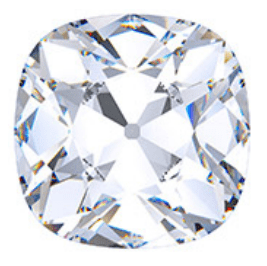

Sign up to begin your Journey with a MOH
These old fashioned diamond cuts, including the old mine cut, are rarely seen in modern diamond jewellery and require specialist skill to cut using heritage practises. Each diamond has been custom sourced and selected to fit the setting and ring style.
A diamond cut, both for the antique and the modern, is not just about smoothening the gem and making it sparkle. A diamond cut has the potential of enhancing its light capturing ability, revealing its inner beauty and ultimately making it more appealing. In the past century, diamond cutters used to make use of their hands for cutting and shaping diamonds instead of the sophisticated technology that is used today. Because of this reason, the diamond cuts had a unique, warm and romantic appeal that lacks in the current cuts.
Antique diamond cuts have some architectural demeanours because vintage diamond cutters used to aim at removing as little material as possible from the original rough diamond. The process involved 3 main steps; cleaving or splitting, cutting, and finally polishing.
Although diamond cutting technologies revolutionised greatly during the 1800s, the pieces still maintained an irreplaceable charm and beauty to them. Some of the most priced vintage diamond cuts that are crawling back to fashion include:

This was the primary shape used in the Victorian and Edwardian eras. Old Mine Cushion cut diamonds had basically two certainties, a three dimensional structure and an eight fold faceting symmetry which with the brillianteering, a table and culet summed up to 58 facets.
The typical number of facets for such cuts is either 16 to 18. Single cut diamonds don’t have the light performance that full cut diamonds have, due to their low number of facets. Their sparkle is quite low and this is noticeable in larger stones.


Diamonds with this type of cut are identified by an overall depth of the crown to culet, heavy crown and relatively tiny table. Its higher crown, smaller table and larger culet gives the stone an incredible depth and stunning glow. Their shape features a high crown, small table and a large, flat culet. They have 58 facets and have been termed the most complicated vintage diamond cuts. Their general outlook and circular shape resemble the modern round brilliant cut.
The ‘Brilliant’ cut is the modern version of this antique cut. This has an eminent girdle with a cushion-shape. It also has a large culet, deep pavilion, small table and high crown. Often seen in jewellery from the Georgian and Victorian eras, old mine cut diamonds are similar to a modern day cushion cut.


Rose cuts diamonds rose to fame in the early 1500s. These diamonds are cut in a way that mimics the rose bud petals. They are characterised by a dome shaped crown with all facets (3-24) combined centrally, and a flat bottom. For most people, this cut signifies the natural sparkling diamond, love and romance. They have since regained their fame after the Art Deco period due to their magnetising geometric shapes.
A table cut diamond is so named for the simple fact that the top is flat, like an ordinary table. Each of the four sides has a simple facet similar to a bevel. These diamonds, although found in the 16th century, were most often utilised from the 17th through the earlier 18th century in jewelry.


The origins of French Cut Diamonds is from 14th century. French Cut Diamonds are a natural evolution of the Table Cut. the French Cut is that it is easy to create but produces a spectacular play of light.
The Mazarin Cut was developed in the mid 17th century. The Mazarin Cut Diamond is often considered to be the first true brilliant cut. The Mazarin Cut Diamond has 17 crown facets and 17 pavilion facets and has also been known as the "double cut brilliant", as it was the next stage in diamond cutting 'evolution' after the Single Cut Diamond.


The Peruzzi Diamond enjoys most light environments and offers slow events of very large flashes of colourful fire and white light return. Its contrast is derived from its slender corner facet shapes and from the transformation of primary direct light return to reflected secondary light return when in movement.